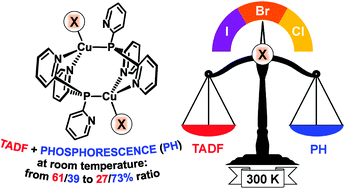New Cu(i) halide complexes showing TADF combined with room temperature phosphorescence: the balance tuned by halogens†
Abstract
A series of Cu(I) halide complexes derived from tris(2-pyridyl)phosphine (Py3P), [Cu2(Py3P)2X2] (X = Cl, Br, I), have been synthesized by a straightforward reaction in solution or through a mechanochemical route. At room temperature, the solid complexes exhibit bright dual-mode photoluminescence (λmax = 520–550 nm, τ = 14.5–20.0 μs, and ΦPL ≈ 53%), expressed by thermally activated delayed fluorescence (TADF) combined with phosphorescence (PH), originating from 1(M + X)LCT and 3(M + X)LCT excited states, respectively. Remarkably, the balance of these radiative processes at 300 K is regulated by halogen atom nature, switching from TADF-assisted phosphorescence to PH-admixed TADF. The emission of [Cu2(Py3P)2Cl2] at 300 K is largely contributed by PH (73%) admixed with the TADF fraction (27%) and [Cu2(Py3P)2Br2] also emits mainly PH (65%) admixed with the larger TADF fraction (35%). Meanwhile, for [Cu2(Py3P)2I2], the TADF channel becomes dominating (61%) and PH contribution drops to 39%. The photophysical study corroborated by (TD)DFT computations has revealed that this effect arises mainly from the narrowing of the ΔE(S1 − T1) gap of the [Cu2(Py3P)2X2] complexes in the order Cl (1500 cm−1) > Br (1250 cm−1) > I (1000 cm−1) which facilitates the TADF pathway and suppresses PH in the same order.



 Please wait while we load your content...
Please wait while we load your content...